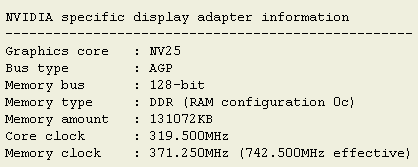Testing Setup and Overclocking
System setup and notes
- Intel Pentium 4 2.4GHz 'Northwood'
- Abit TH7-II RAID I850 'Tehama' Motherboard (38 BIOS)
- 256MB PC800 Samsung PC800 RAMBUS RIMMS (2 x 128MB)
- Thermal Take Volcano S478 cooler
- Creative Geforce4 Ti 4600 at 300/660 MHz
- Creative Geforce4 Ti 4600 at 320/740 MHz (overclocked)
- Leadtek Geforce3 Ti 500 at 240/500 (stock speeds)
- 120GB Western Digital 120JB hard drive with 8MB cache, 7200rpm
- Liteon 32x12x40 CDRW
- Liteon 16x DVD
- Samcheer 420w PSU
- 21" Sony G500 FD monitor
Software
- Windows XP Professional Build 2600.xpclient.010817-1148
- Nvidia Detonator XP 28.32 drivers
- 3DMark 2000
- 3DMark 2001SE
- Vulpine GL Mark
- Serious Sam 2 Demo
- Comanche 4 Benchmark
- Quake 3 v1.30
All benchmarks were conducted with vertical sync' disabled. Benchmarks were run 3 times consecutively, an average score was taken. The host system was configured for maximum performance. A fresh installation of Windows XP was used in both instances. We've chosen to pair up our two cards with arguably the most potent host CPU / memory combination currently available. It's only just that a top-end card should be benchmarked with other cutting-edge components.
One important aspect to note is the relative running speed of our Creative Geforce4 Ti 4600. Prima facie, this would seem like a non-issue, as the reference card is rated at 300MHz core and 650 MHz memory (DDR) respectively. Indeed, the actual box displays a memory speed of 650MHz. The reason we highlight this fact is due to the Creative running faster than its stated speed, a little graphic from Riva Tuner should explain all.

The core speed is almost exactly as stated. The memory speed, however, is 11.5 MHz faster than specification. This will not make a major difference in our benchmarks, but merely serves as a reminder that manufacturers often slightly overclock their product to make them appear more faster than similar competition. We have no problems with Creative doing this, it just makes our card that little bit faster than anticipated.
Overclocking
We were intrigued to see just how far the Creative Ti 4600 could go when pushed a little. We believe that the potential overclockability of video cards is down to 80% luck (in receiving an unexpectedly good or poor performing card) and 20% down to external cooling. We used the latest incarnation of Riva Tuner for all our low-level overclocking efforts.
We raised the core speed by 5MHz per time, and then looped the nature benchmark contained within 3DMark 2001SE three times. It's an excellent test of the core's capacity as it is almost entirely GPU-limited. We managed to get to 320MHz core with excellent stability. 325MHz core would result in the benchmark locking up from time to time, a classic sign that not all is well with the GPU. We then proceeded to carry out a similar test with the memory, this time using the lobby level. Our efforts met with some success as we were able to run at 740MHz without any difficulty. 750MHz gave the odd artifact here and there. We settled for a very respectable 320 / 740MHz overclock. Rivatuner saw the final oveclock slightly differently.

We'll be directly comparing the Creative Geforce4 Ti 4600 against the Geforce3 Ti 500, the card that it effectively replaced as the high-performance solution in Creative's range. Due to time constraints, we were not able to include the Radeon 8500 in our benchmarks, we hope to add the results in due course.









